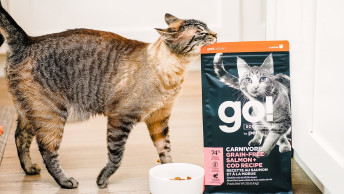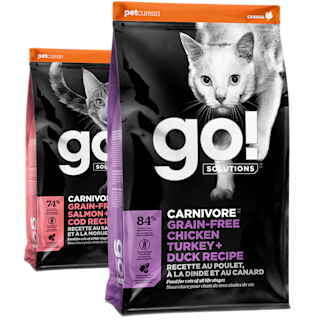February 2, 2021
How Much Protein Does Your Cat Need?

What is protein?
Proteins are the building blocks of your cat’s body and consist of chains of amino acids. They can range in size from only a few amino acids to large, complex molecules. Protein levels in cat foods have been slowly creeping up over the years, but how much protein do cats really need?
Protein requirements
Protein requirements vary depending on species and life stage. Kittens have higher requirements than adult cats because the additional protein is necessary for new tissue development. According to the Association of American Feed Control Officials (AAFCO), adult cats and kittens require a minimum of 26% and 30% protein on a dry matter basis, respectively, while ensuring that all essential amino acid requirements are met. The essential amino acids are those that your cat cannot make on its own, so they must be obtained from food.
Dietary protein sources
The amount of dietary protein your cat requires also depends on lifestyle and health conditions. Higher protein levels may be needed in some circumstances, such as highly active cats or critically ill patients.
For these cats, we offer Go! Solutions Carnivore recipes which are available in a range of different protein options and contain up to 84% of protein from animal protein sources in our kibble recipes, and up to 99% in our Tetra Pak carton wet food recipes. However, high protein diets may not be suitable for all cats. In fact, excess dietary protein cannot be stored by the body. Rather, the nitrogen in protein is converted to urea and excreted in the urine, which is a wasteful end to a costly ingredient and contributes to harmful environmental ammonia levels.
For most cats, a more moderate protein level is recommended, as found in our Go! Solutions Skin + Coat Care recipes. Lastly, some cats may experience adverse reactions to some of the proteins that are commonly used in cat foods. If your cat experiences itchy skin, diarrhea, or licks excessively, a limited ingredient diet from our Go! Solutions Sensitivities line-up of cat foods may help reduce these symptoms.
Good sources of protein that are commonly used in cat foods fall into three main categories: meals (e.g. chicken meal, lamb meal), fresh meat/fish/poultry (e.g. de-boned turkey, de-boned venison, de-boned salmon) and plant-based proteins (e.g. pea protein). When foods containing protein are eaten, the protein is broken down into amino acids which are then absorbed and used to make body proteins. However, not all proteins are created equal. A highly digestible protein source that contains greater amounts of essential amino acids is considered a high-quality protein. Some proteins contain low levels of one or more essential amino acids, referred to as the limiting amino acid, usually methionine, lysine or tryptophan. However, foods can easily be combined to provide the correct balance of all essential amino acids. These foods have what are called “complementary proteins”.
Protein is a vital component in your cat’s food and provides the essential amino acids to help keep your pet strong and healthy. Whether your cat needs a diet that is high in protein, moderate in protein, or contains a novel protein, Go! Solutions offers a variety of recipes to meet your cat's dietary needs.

Recommended Solutions
Carnivore Recipes for Cats
Up to 99% of protein from premium-quality animal sources
Carnivore


